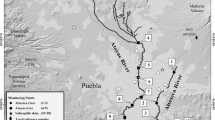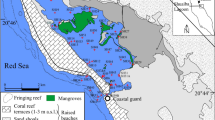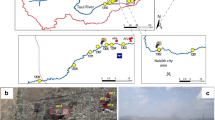Abstract
Sedimentation of metals preserves historical records of contaminant input from local and regional sources, and measurement of metals in sediment cores can provide information for reconstruction of historical changes in regional water and sediment quality. Sediment core was collected from Stege Marsh located in central San Francisco Bay (California, USA) to investigate the historical input of trace metals. Aluminum-normalized enrichment factors indicate that inputs from anthropogenic sources were predominant over natural input for Ag, Cu, Pb, and Zn. Among these, lead was the most anthropogenically impacted metal with enrichment factors ranging from 32 to 108. Depth profiles and coefficients of variation show that As, Cd, and Se were also influenced by anthropogenic input. The levels of these anthropogenically impacted metals decline gradually towards the surface due to regulation of the use of leaded gasoline, municipal and industrial wastewater discharge control, and closure of point sources on the upland of Stege Marsh. Although trace metal contamination is expected to be continuously declining, the rates of decline have slowed down. For lead, it is estimated to take 44, 82, and 153 years to decrease to probable effects level (112 μg/g), the San Francisco Bay ambient surface sediment level (43.2 μg/g), and the local baseline levels (5 μg/g), respectively. Some metals in surface sediments (0–6 cm) are still higher than sediment quality guidelines such as the probable effects level. To further facilitate the recovery of sediment quality, more efficient management plans need to be developed and implemented to control trace metals from non-point sources such as stormwater runoff.




Similar content being viewed by others
References
Bay Area Census. (2000). Population by County, 1860–2000, Bay Area Census. http://www.bayareacensus.ca.gov. Assessed 20 January 2008.
Brinkmann, U. A. T., & de Kok, A. (1980). Production, properties, and usage. In R. D. Kimbrough, (Ed.), Halogenated bipheynyls, terpenyls, naphthalenes, dibenzodioxins and related products (2nd ed., Vol. 4). Topics in environmental health. Amsterdam: Elsevier/North-Holland Biomedical Press.
Cantwell, M. G., King, J. W., Burgess, R. M., & Appleby, P. G. (2007). Reconstruction of contaminant trends in a salt wedge estuary with sediment cores dated using a multiple proxy approach. Marine Environmental Research, 64, 225–246. doi:10.1016/j.marenvres.2007.01.004.
Cook, J. M., Gardner, M. J., Griffiths, A. H., Jessep, M. A., Ravenscroft, J. E., & Yates, R. (1997). The comparability of sample digestion techniques for the determination of metals in sediments. Marine Pollution Bulletin, 34, 637–644.
Daskalakis, K. D., & O’Connor, T. P. (1995). Normalization and elemental sediment contamination in the coastal United States. Environmental Science & Technology, 29, 470–477. doi:10.1021/es00002a024.
Farmer, J. G., & Lovell, M. A. (1984). Massive diagenetic enhancement of manganese in Loch Lomond sediments. Environmental Technology Letters, 5, 257–262.
Flegal, A. R., Brown, C. L., Squire, S., Ross, J. R. M., Scelfo, G. M., & Hibdon, S. (2007). Spatial and temporal variations in silver contamination and toxicity in San Francisco Bay. Environmental Research, 105, 34–52. doi:10.1016/j.envres.2007.05.006.
Goals Project. (1999). Baylands ecosystem habitat goals: A report of habitat recommendation. Oakland, CA: U.S. Environmental Protection Agency/San Francisco Bay Regional Water Quality Control Board.
Hartmann, P. C., Quinn, J. G., Cairns, R. W., & King, J. W. (2005). Depositional history of organic contaminants in Narragansett Bay, Rhode Island, USA. Marine Pollution Bulletin, 50, 388–395. doi:10.1016/j.marpolbul.2004.11.020.
Hornberger, M. I., Luoma, S. N., van Green, A., Fuller, C., & Anima, R. (1999). Historical trends of metals in the sediments of San Francisco Bay, California. Marine Chemistry, 64, 39–55. doi:10.1016/S0304-4203(98)80083-2.
Hwang, H.-M., Green, P. G., Grosholz, E. D., Carr, R. S., Higashi, R. M., & Anderson, S. A. (2008a). Quality assessment of sediments in tidal salt marshes in California using a sediment quality triad approach. Journal of Environmental Science and Health Part A (submitted).
Hwang, H.-M., Green, P. G., Higashi, R. M., & Young, T. M. (2006a). Tidal salt marsh sediment in California, USA. Part 2: Occurrence and anthropogenic input of trace metals. Chemosphere, 64, 1899–1909. doi:10.1016/j.chemosphere.2006.01.053.
Hwang, H.-M., Green, P. G., & Young, T. M. (2006b). Tidal salt marsh sediment in California, USA. Part 1: Occurrence and sources of organic contaminants. Chemosphere, 64, 1383–1392. doi:10.1016/j.chemosphere.2005.12.024.
Hwang, H.-M., Green, P. G., & Young, T. M. (2008b). Tidal salt marsh sediment in California, USA. Part 3: Current and historic toxicity potential of contaminants and their bioaccumulation. Chemosphere, 71, 2139–2149. doi:10.1016/j.chemosphere.2008.01.005.
Lu, X. Q., Werner, I., & Young, T. M. (2005). Geochemistry and bioavailability of metals in sediments from northern San Francisco Bay. Environment International, 31, 593–602. doi:10.1016/j.envint.2004.10.018.
Nriagu, J. O. (1990). The rise and fall of leaded gasoline. The Science of the Total Environment, 92, 13–28. doi:10.1016/0048-9697(90)90318-O.
Nriagu, J. O. (1994). Mercury pollution from the past mining of gold and silver in the Americas. The Science of the Total Environment, 149, 167–181. doi:10.1016/0048-9697(94)90177-5.
Schiff, K. C., & Weisberg, S. B. (1999). Iron as a reference element for determining trace metal enrichment in southern California coastal shelf sediments. Marine Environmental Research, 48, 161–176.
SFBRWQCB. (1998). Staff report: Ambient concentrations of toxic chemicals in San Francisco Bay sediments. Oakland, CA: San Francisco Bay Regional Water Quality Control Board.
SFBRWQCB. (1999). Regional toxic hot spot cleanup plan. Oakland, CA: San Francisco Bay Regional Water Quality Control Board.
SFBRWQCB. (2000). Fifty years of protecting Bay area waters. Oakland, CA: San Francisco Bay Regional Water Quality Control Board.
Squire, S., Scelfo, G. M., Revenaugh, J., & Flegal, A. R. (2002). Decadal trends of silver and lead contamination in San Francisco Bay surface waters. Environmental Science & Technology, 36, 2379–2386. doi:10.1021/es015746r.
Taylor, S. R., & McLennan, S. M. (1985). The continental crust: Its composition and evolution. Blackwell Scientific: Oxford.
Topping, B. R., & Kuwabara, J. S. (2003). Dissolved nickel and benthic flux in South San Francisco Bay: a potential for natural sources to dominate. Bulletin of Environmental Contamination and Toxicology, 71, 46–71. doi:10.1007/s00128-003-0129-7.
URS. (2000). Filed sampling and analyses results, University of California, Berkeley Richmond Field Station/Stege Marsh, Richmond, California. Oakland, CA: URS.
Van Dolha, R. F., Riekerk, G. H. M., Bergquist, D. C., Felber, J., Chestnut, D. E., & Holland, A. F. (2008). Estuarine habitat quality reflects urbanization at large spatial scales in South Carolina’s coastal zone. The Science of the Total Environment, 390, 142–154. doi:10.1016/j.scitotenv.2007.09.036.
Velinsky, D. J., Wade, T. L., Schlekat, C. E., McGee, B. L., & Presley, B. J. (1994). Tidal river sediments in the Washington, D.C. area. I. Distribution and sources of trace metals. Estuaries, 17, 305–320. doi:10.2307/1352665.
Venkatesan, M. I., de Leon, R. P., van Geen, A., & Luoma, S. N. (1999). Chlorinated hydrocarbon pesticides and polychlorinated biphenyls in sediment cores from San Francisco Bay. Marine Chemistry, 64, 85–97. doi:10.1016/S0304-4203(98)90086-X.
Yee, D., Grieb, T., Mills, W., & Sedlak, M. (2007). Synthesis of long-term nickel monitoring in San Francisco Bay. Environmental Research, 105, 20–33. doi:10.1016/j.envres.2007.02.005.
Acknowledgements
We are thankful to Dr. Frances Malamud-Roam for her help in field sampling. We would like to thank Rodelia Busalpa, Yun Lu, William Schilling, and Marlene Relja for their help in laboratory chemical analysis. This research has been supported by a grant from the US Environmental Protection Agency’s Science to Achieve Results (STAR) Estuarine and Great Lakes (EaGLe) Coastal Initiative through funding to the Pacific Estuarine Ecosystem Indicator Research (PEEIR) Consortium, US EPA Agreement #EPA/R-82867601.
Author information
Authors and Affiliations
Corresponding authors
Rights and permissions
About this article
Cite this article
Hwang, HM., Green, P.G. & Young, T.M. Historical trends of trace metals in a sediment core from a contaminated tidal salt marsh in San Francisco Bay. Environ Geochem Health 31, 421–430 (2009). https://doi.org/10.1007/s10653-008-9195-4
Received:
Accepted:
Published:
Issue Date:
DOI: https://doi.org/10.1007/s10653-008-9195-4




